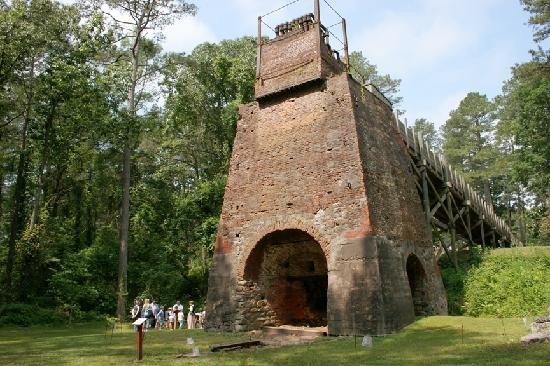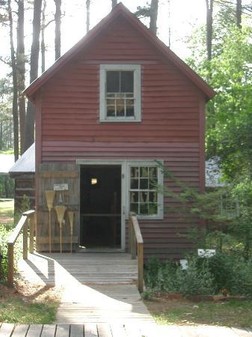Furnace Town
Introduction
Text-to-speech Audio
Furnace Town is an outdoor museum located about 5 miles from Snow Hill, Maryland where the Nassawango Iron Furnace sits back in the woods. Furnace Town conveys the living standards back in 1800s using a living history format and live demonstrations. Enactors portray broom makers, Blacksmiths, weavers, etc. Furnace Town gives the aspect of individuals to what time periods were like in the 1800s. If you are every taking a drive down Route 12 headed towards Snow Hill, Maryland it would not hurt to take a pit stop at Furnace Town and learn some background information about our history.
Images
Furnace Town

Living Heritage Museum

Backstory and Context
Text-to-speech Audio
When you think back in society you would have never guessed how objects were made solely by a furnace and are still conveyed that way today. The bog ore under the Nassawango Creek was of poor quality, and difficult to smelt and purify. Even though the company was able to produce great amounts of iron, the poor quality made it worth very little, and the company was eventually forced to sell the furnace. The furnace was then bought in 1837 for $3,000 by a local judge, Thomas A. Spence. Spence studied the production of iron ore and introduced the "hot blast" system to the furnace, making it the first in America to use this system, and also increasing production. This production increase enabled Furnace Town to prosper and have new businesses such as a shoemaker, bank, post office and boarding house. This prosperity continued until 1840, when the manufacturing of iron became more prosperous elsewhere, and the furnace was again sold. The furnace deteriorated, and eventually the town became a ghost town.
Furnace Town has an historical impact because it was an important part of the industrial age. The Furnace was built on the site of a former grist and saw mill, and designed to manufacture iron by smelting bog ore. The ore was found in the nearby swampy soil along the Nassawango Creek. Mules then transported the ore to the furnace by pulling the bog ore carts up the hill to the top of the furnace stack. The carts were then unloaded, and the mules then backed down the hill. Every day, 3 tons of ore were loaded into the furnace in this manner and then heated with charcoal. To make the furnace work, there were large waterwheels that maintained the heat of the fire burning by powering huge bellows. After about 24 hours, the furnace was opened and the ore would spill out into molds, called "pigs" and "sows". These "pig iron" molds would then be collected and taken to Baltimore or Philadelphia to be used in various industries.
In 1962, the Worcester County Historical Society began a long range program to stablize the furnace and rebuild the village. Period buildings were moved in to replace the rotted wooden structures. In 1983, artisans were trained to interpret crafts and life in the period 1820-1850, and a visitors center was built. Today, there are tours of the village, and an annual Celtic Festival is held. Furnace Town was not only built to gain tourists attractions but also to give local students a close encounter of what society was like in the 1800s. Furnace Town is largely involved with elementary school trips pertaining to history. Students are able to dress up as if they are back in time which gives students more of a real life aspect.
Furnace Town has an historical impact because it was an important part of the industrial age. The Furnace was built on the site of a former grist and saw mill, and designed to manufacture iron by smelting bog ore. The ore was found in the nearby swampy soil along the Nassawango Creek. Mules then transported the ore to the furnace by pulling the bog ore carts up the hill to the top of the furnace stack. The carts were then unloaded, and the mules then backed down the hill. Every day, 3 tons of ore were loaded into the furnace in this manner and then heated with charcoal. To make the furnace work, there were large waterwheels that maintained the heat of the fire burning by powering huge bellows. After about 24 hours, the furnace was opened and the ore would spill out into molds, called "pigs" and "sows". These "pig iron" molds would then be collected and taken to Baltimore or Philadelphia to be used in various industries.
In 1962, the Worcester County Historical Society began a long range program to stablize the furnace and rebuild the village. Period buildings were moved in to replace the rotted wooden structures. In 1983, artisans were trained to interpret crafts and life in the period 1820-1850, and a visitors center was built. Today, there are tours of the village, and an annual Celtic Festival is held. Furnace Town was not only built to gain tourists attractions but also to give local students a close encounter of what society was like in the 1800s. Furnace Town is largely involved with elementary school trips pertaining to history. Students are able to dress up as if they are back in time which gives students more of a real life aspect.
Sources
Furnace Town:
http://www.furnacetown.com
Spirit stories:
http://www.prairieghosts.com/furnace.html
